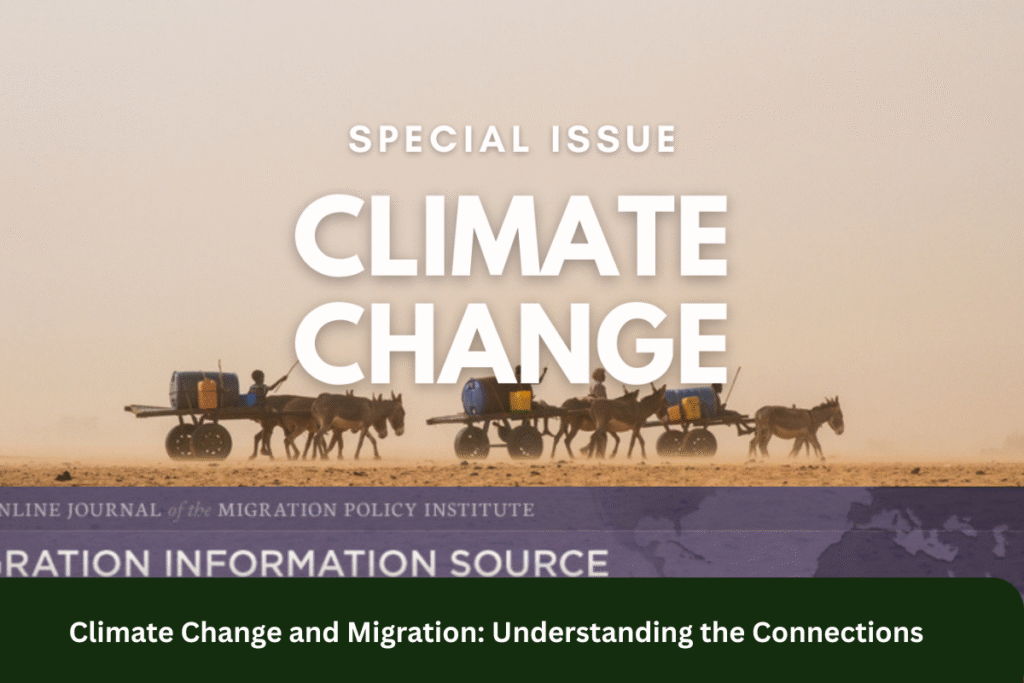
As the effects of climate change become increasingly apparent, its connection to migration is a growing concern. Rising sea levels, extreme weather events, and resource scarcity are forcing people to leave their homes in search of safer, more sustainable living conditions. Climate-induced migration, often referred to as “climate refugees,” is a complex issue that requires urgent attention and a comprehensive understanding of its causes, impacts, and potential solutions. This article explores the links between climate change and migration, shedding light on how climate change is reshaping migration patterns and what can be done to address this pressing issue.
1. What is Climate-Induced Migration?
Climate-induced migration refers to the movement of people who are forced to leave their homes or countries due to the direct or indirect impacts of climate change. Unlike other types of migration, climate-induced migration is driven primarily by environmental factors such as extreme weather events, rising sea levels, desertification, and the loss of arable land. Climate change-related migration can be internal (within the same country) or international (across borders), and it often results in people seeking refuge in more climate-resilient areas.
a. Types of Climate-Induced Migration
- Slow-onset migration: This occurs over time due to gradual environmental changes such as rising sea levels, desertification, and long-term droughts. People may gradually move away from areas that become increasingly uninhabitable due to climate impacts.
- Rapid-onset migration: This type of migration occurs as a result of sudden and extreme events, such as hurricanes, floods, wildfires, and other natural disasters that force people to flee their homes quickly.
2. How Does Climate Change Contribute to Migration?
Climate change creates environmental conditions that make certain regions uninhabitable, forcing populations to relocate. The primary ways in which climate change drives migration include:
a. Rising Sea Levels and Coastal Erosion
Rising sea levels, caused by the melting of polar ice caps and the thermal expansion of seawater, pose a significant threat to low-lying coastal areas. As sea levels rise, coastal communities face the loss of land, homes, and infrastructure. Coastal erosion accelerates, leading to increased flooding and storm surges that make living conditions untenable.
- Example: In countries like Bangladesh, Maldives, and Kiribati, rising sea levels are already displacing populations, leading to internal migration and creating pressure on neighboring countries to offer asylum or resettlement.
b. Extreme Weather Events
The increased frequency and intensity of extreme weather events, such as hurricanes, droughts, floods, and heatwaves, are forcing people to flee their homes. These events not only destroy homes and infrastructure but also disrupt agricultural activities, leading to food and water insecurity.
- Example: In Honduras and Guatemala, repeated hurricanes and flooding have forced thousands of people to migrate, often seeking refuge in neighboring countries like the United States.
c. Desertification and Land Degradation
In many parts of the world, climate change is leading to desertification—the process by which fertile land becomes desert as a result of prolonged drought and the overuse of natural resources. This reduces the availability of arable land for agriculture, a primary livelihood for many people. When land degradation occurs, communities are forced to move in search of more fertile land and better living conditions.
- Example: In Sub-Saharan Africa, where droughts and desertification are common, rural populations are increasingly migrating to urban areas or neighboring countries in search of food, water, and employment opportunities.
d. Water Scarcity
Climate change is intensifying water scarcity by altering precipitation patterns and reducing the availability of freshwater. This has a direct impact on agriculture, drinking water, and sanitation, leading to heightened competition for resources. When communities cannot access sufficient water, they may be forced to migrate.
- Example: In Syria, water scarcity and prolonged droughts have contributed to social unrest and migration, as people moved from rural areas to urban centers in search of water and agricultural land.
e. Food Insecurity
Climate change-induced changes in weather patterns, such as irregular rainfall and rising temperatures, are affecting food production. Crop yields are decreasing, and agricultural lands are becoming less fertile. This leads to food insecurity, which can force people to migrate to find better conditions for growing food or accessing food markets.
- Example: In East Africa, prolonged droughts have caused crop failures, contributing to food insecurity and forcing rural populations to migrate to cities or neighboring countries for survival.
3. The Impact of Climate-Induced Migration
Climate-induced migration has far-reaching social, economic, and political consequences. Some of the key impacts include:
a. Pressure on Urban Areas
As rural populations migrate to urban areas due to climate change impacts, cities may face increased pressure on infrastructure, housing, healthcare, and social services. This can lead to overcrowding, the spread of disease, and the creation of informal settlements with inadequate access to resources.
b. Increased Vulnerability of Migrants
Climate migrants often face increased vulnerability, particularly if they are displaced across borders. They may lack legal protection, access to basic services, and the ability to secure employment. As a result, many climate migrants face heightened risks of poverty, exploitation, and discrimination.
c. Conflict and Resource Competition
Climate change can exacerbate resource scarcity, leading to tensions and competition over land, water, and food. In some cases, this can lead to conflicts between migrating populations and host communities, as well as cross-border tensions between nations.
d. Strain on International Aid and Refugee Systems
As climate change leads to more migration, countries may struggle to accommodate climate refugees. Existing refugee systems, which are often already stretched by political or economic crises, may face difficulties in providing adequate support to climate migrants.
4. Strategies for Addressing Climate-Induced Migration
To address the challenges of climate-induced migration, it is essential to implement a range of solutions that address both mitigation and adaptation. Some strategies include:
a. Climate-Resilient Infrastructure
Investing in climate-resilient infrastructure, such as flood defenses, drought-resistant crops, and water management systems, can help reduce the need for migration by allowing communities to remain in their homes despite climate impacts.
b. Migration and Resettlement Policies
Governments should develop policies that support the resettlement and protection of climate migrants. These policies should provide safe, legal pathways for migration and ensure access to basic services, such as healthcare, education, and employment.
c. International Cooperation
Climate-induced migration is a global issue that requires international cooperation. Countries need to work together to address the root causes of migration, such as reducing emissions, investing in adaptation strategies, and supporting vulnerable regions with financial and technical assistance.
d. Community-Based Adaptation
Supporting local communities in adapting to climate change is essential for reducing migration. Community-based adaptation projects, such as sustainable agriculture, renewable energy projects, and disaster risk reduction measures, can help communities remain resilient in the face of climate impacts.
5. FAQs
1. What is climate-induced migration?
2. What are the main causes of climate-induced migration?
3. How does climate change affect migration patterns?
4. What are the risks faced by climate migrants?
5. What can be done to address climate-induced migration?
6. Conclusion
Climate-induced migration is an urgent issue that will continue to affect millions of people worldwide as the impacts of climate change worsen. Understanding the connections between climate change and migration is crucial for developing effective strategies to support displaced populations, reduce the causes of migration, and build climate resilience. By investing in adaptation measures, creating supportive policies, and fostering international cooperation, we can help mitigate the impacts of climate-induced migration and protect vulnerable communities from the worst effects of climate change.
